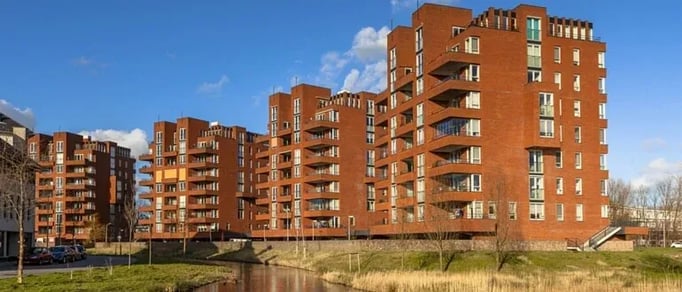3 min read
7 Ways to Lower Energy Consumption in Multi-Family Properties
![]() David Schwartz
Jun 15, 2016 6:23:13 PM
David Schwartz
Jun 15, 2016 6:23:13 PM

For multi-family property owners, keeping a watchful eye on energy consumption is imperative. Not only do landlords have a significant opportunity for lowering their city's carbon footprint, they also have the responsibility of paying some hefty utility bills.
According to the Institute of Real Estate Management's 2010 Income & Expense Survey, total utility expenses account for approximately 25 percent of all multi-family operating expenses, trailing only payroll, taxes, and insurance. And in places like New York City, where landowners are legally responsible for paying water bills in the face of continually rising prices, that number can be even greater.
Though energy costs will fluctuate according to factors such as season, location and tenant usage, there are many things owners can do to lower energy consumption (oftentimes dramatically). In this article, we'll review 7 of our most effective tips for conserving energy and lowering costs.
Read more about the water conservation facts everyone should know!
Optimize Heating Systems
Landlords of older apartment buildings have unique challenges when it comes to heating and cooling. Typically, pre-1940s buildings will either utilize radiant (using steam or hot water) or electric baseboard heating systems in conjunction with window-mounted AC units. The pipes of your central heating system carry hot water, steam, and air 24/7. Over time, gunk and debris builds up, compromising efficiency. Clean the pipes once a year for more efficient energy usage and a longer machine life span.
Keep Vents Open
There's a myth that closing vents can reduce energy consumption. The logic goes, if a room isn't being heated or cooled, less energy is being used. Unfortunately, closing vents actually causes air conditioning and heating systems to work overtime!
Additionally, commit to replacing filters on a regular basis (ideally once a month). Otherwise, dust buildup will block airflow, thus requiring more energy to pump the air.
Install Water-Regulating Shower Heads
If you're currently paying tenant water bills, installing low-flow fixtures may be your best opportunity for overall savings. As reported by analysts at Circle of Blue, water now costs 41 percent more than it did in 2010. Unfortunately, tenants who aren't footing the bill have very little incentive to curb water usage.
While installing low-flow shower heads is a step in the right direction, it is often not enough. Tenants who strongly prefer high-flow shower heads will often install their own devices, either throwing yours away or re-installing it before move-out. As it's nearly impossible to monitor such actions, landlords are often left puzzled over hefty water bills despite their best efforts and investments in water conservation products.
The solution? Install a hidden, tamper-proof water regulator. The Water Scrooge sits behind shower walls, effectively regulating water flow. In combination with faucet regulators, water usage can typically be reduced by 30 percent, translating to thousands of dollars saved for multi-family units.
Upgrade to CFLs or LEDs
As a landlord, you're responsible for lighting several spaces, including hallways, office areas, common rooms, parking lots, and possibly laundry facilities. While that may not seem like much, consumption adds up fast. Thankfully, energy-saving CFL and LED light bulbs have become significantly cheaper, lighter, and more effective in recent years.
The earliest CFLs of the mid-1980s retailed for approximately $25-35. Today you can find CFLs for as cheap as one dollar (when bought in bulk). Similarly, since 2008, the cost of LEDs has fallen 85 percent. Though both types of bulbs offer unique advantages and disadvantages, both also last thousands of hours longer than their incandescent grandfathers and require significantly less energy.
On average, $30 and $80 in electricity costs are saved over the lifetime of each ENERGY STAR bulb. If you have a property that contains 500 lights you're responsible for running, that’s an estimated savings of $15,000 to $40,000 over time. Click here to learn more about CFLs and LEDs.
Insulate and Seal
Improving insulation can have a major impact on heating bills. By insulating your boiler pipes you can expect to save around $1 per foot, per year. This will prevent heat loss through the building's distribution and recirculation systems.Insulating furnace ductwork can also provide significant savings.
Also, you'll want to maintain 12 to 18 inches of insulation above your building's top floor. Since hot air rises, the extra insulation will prevent extra air from escaping through the roof. Wall insulation is another option. Though more expensive, it can yield worthwhile savings for colder climates.
Laundry Room Regulations
If you're a property owner who is responsible for maintaining a public laundry facility, it's within your rights to set certain regulations. Post signs within your facility encouraging tenants to wash with cold water. According to LG Electronics, heating the water in the wash drum accounts for about 90 percent of machine energy usage.
Additionally, discourage tenants from "over-stuffing" dryers, as it's counterproductive. A good rule of thumb is to leave 25 percent of the dryer unfilled so there's room for movement. Put too many articles in the dryer, and you'll have to run the machine more than once.
As you can see, there are many ways to conserve energy in multi-family properties. We hope you've enjoyed this article and have learned some new tips.


